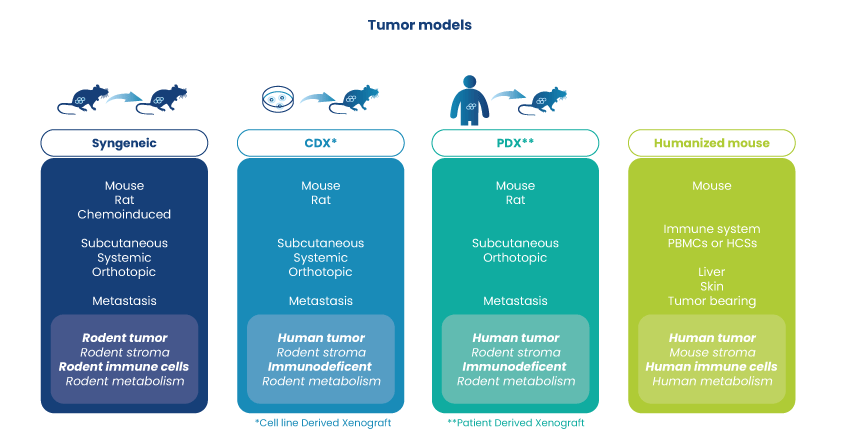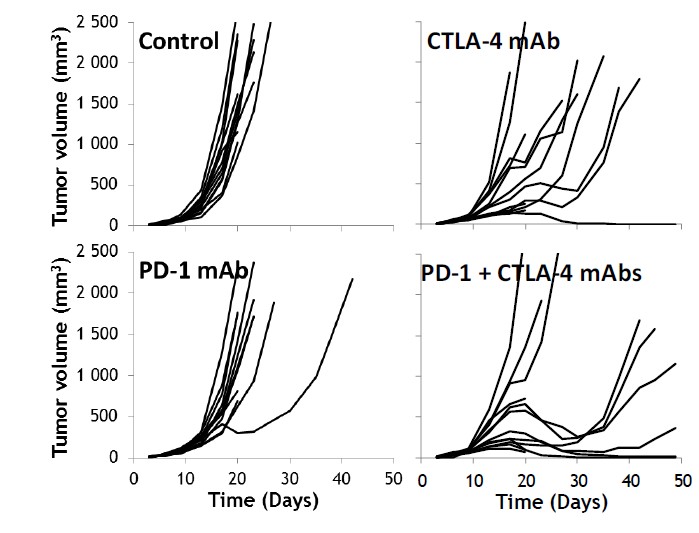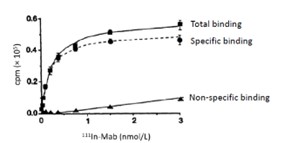
Syngeneic Mouse Models for Drug-Host Immune System Interactions Study
Treatments targeting immune cells such as immune checkpoint modulators, bispecific antibodies or adoptive T cell transfer have now demonstrated their clinical efficacy and some of these therapies have already been approved. Anticancer vaccines via peptides, mRNA or viruses are also gaining more and more interest as alternative strategies. However, preclinical development of these therapies requires models adapted to each target and class of therapeutics. To address these needs, Oncodesign Services provides the option to use syngeneic mouse models.
Syngeneic model systems remain one of the best options to analyze physiologically relevant interactions between tumor and immune cells. Indeed, in syngeneic models, animals are grafted with tumor cells issued an animal of the same lineage. The main advantage of these models is the use of immunocompetent mice, thus allowing the study of the complex relationships between cancer and the immune system and the evaluation of immunomodulatory therapies.

Oncodesign Services provides a large bank of syngeneic tumor models, including breast cancer, melanoma, bladder cancer, etc .
Readouts in mouse syngeneic models
Tumor volume
FACS
Functional assays
Immunohistochemistry
Cytokine profiles
Examples of syngeneic mouse tumor models available at Oncodesign Services
(contact us for complete list)
| Name | Organ | Histological Type | Host rodent species |
| 4T1 | Breast | Carcinoma transitional | Balb/c Mouse |
| AY27 | Bladder | Carcinoma | F344 Ficher Rat |
| C6 | Brain | Glioma | Nude Rat |
| C6 | Brain | Glioma | Wistar Rat |
| CT26 | Colon | Carcinoma | Balb/c Mouse |
| EMT6 | Breast | Mammary Carcinoma | Balb/c Mouse |
| GS-9L | Brain | Gliosarcoma | F344 Ficher Rat |
| GV1A1 | Brain | Glioma | BDIX Rat |
| Hepa1-6 | Liver | Hepatocarcinoma | C57BI/6 Mouse |
| MBT-2 | Bladder | Carcinoma | C3H Mouse |
| MBT-II | Bladder | Tumor | Wistar Rat |
| NCTC 2472 | Bone | Sarcoma | C3H Mouse |
| R3327H | Prostate | Adenocarcinoma | Copenhagen Rat |
| Renca | Kidney | Carcinoma | Balb/c Mouse |
Case study: Subcutaneous CT26 model – combined immunotherapy and change in immune infiltrate


Mice were SC injected with CT26 murine colon tumor cells at D0. Mice were randomized based on tumor volume at D9 and treated IP with mAb against CTLA-4 (clone 9H10) at 5 mg/kg/inj, PD-1 (clone RMP1-14) at 10 mg/kg/inj (TWx2) or combination of both. Mice were terminated at D20 and tumor analyzed by Flow Cytometry for T cells content.
